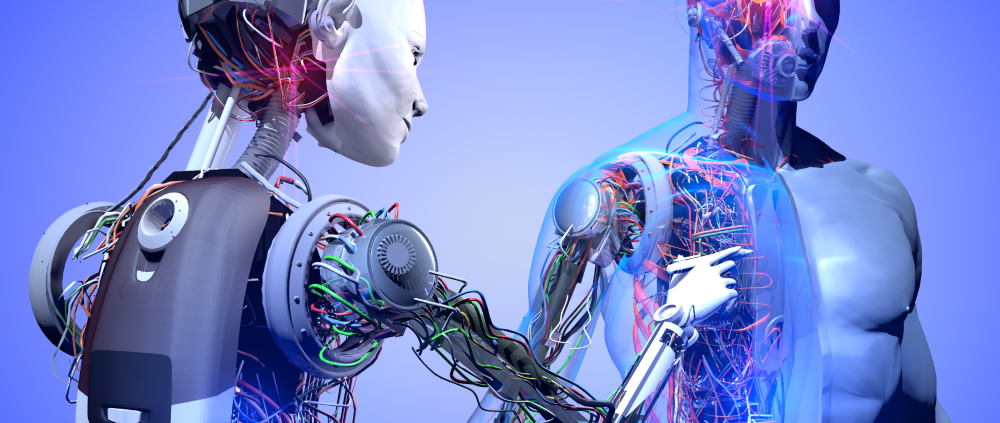Researchers at the University of Tokyo have reported making a two-legged “biohybrid robot” after combining an artificial skeleton with biological muscle, which can walk and pivot underwater.
Biohybrid
Whereas ‘typical’ biohybrid robots can only move in straight lines or perform large turns (making them unsuitable for use in areas with many obstacles), the Tokyo University biohybrid robot can pivot on one foot, enabling it to turn within a small circle. This is thought likely to increase its potential value for future applications.
Only Underwater, For Now
At the moment the new biohybrid robot can only work underwater because its lab-grown muscle would dry out quickly when exposed to air. However, the researchers believe that a future version could be made to walk on land, by using thicker muscles with their own nutrient supplies and by covering the feet in artificial skin (to stop them from drying out or being damaged).
How Was It Made?
The University of Tokyo biohybrid robot was made by combining lab-grown skeletal muscle tissue with flexible artificial legs and 3D-printed feet. The muscle was grown in moulds to create strips and the lightweight skeleton was made from floating styrene board. The skeleton was then covered by a flexible silicone-based body, and the acrylic resin legs (with brass wire weights) and the 3D-printed feet were added. The two lab-grown muscle tissue strips were then used to attach the body to the feet of the robot, thereby completing the “shuffling” legs.
Electric Signals
The muscles in the legs were made to contract to create a “walk” by delivering an electric charge to them via hand-held gold electrodes. The researchers stimulated each leg at five-second intervals, thereby enabling the robot to achieve a walking speed of 5.4 millimetres per minute.
Why?
Head of the research team, Professor Shoji Takeuchi, explained the purpose and the value of the research saying: “By incorporating living tissues as part of a robot, we can make use of the superior functions of living organisms.” He went on to say that: “Our findings offer valuable insights for the advancement of soft flexible robots powered by muscle tissue and have the potential to contribute to a deeper understanding of biological locomotion mechanisms, further enabling us to mimic the intricacies of human walking in robots.”
What Could Biohybrid Robots Be Used For In The Future?
Biohybrid robots (i.e. merging biological and artificial elements) promise transformative advancements across sectors. In medicine, for example, they could revolutionise drug delivery, surgery, and tissue regeneration. Environmental applications could include pollution monitoring and bioremediation, while industrial uses could span manufacturing and precision agriculture. Also, in defence, they offer potential within surveillance and handling hazardous materials and exploration could be redefined by using biohybrids in space and deep-sea missions. In everyday life, biohybrid robots could even be used to enhance elderly care and home automation.
Ethical Considerations
One aspect of the research not covered in the researchers’ online reporting about the robot is the ethical side of biohybrid robot research. For many people, the thought of trying to make ‘cyborg-style robots raises questions about the sanctity of life, autonomy, and privacy. For example, the integration of biological components with artificial systems seems to blur the line between living and non-living entities, raising questions about the moral status and rights of these ‘beings’. It may also raise concerns about autonomy regarding the potential for manipulation or control of biological components, especially if they possess consciousness or ‘sentience.’ Also, using biohybrid robots in surveillance and data collection could pose serious privacy threats, as their capabilities could be used to monitor individuals without consent. Just as there are existential fears about the potential threat posed by AI, some may also see the prospect of self-replicating or evolving biohybrid systems as being dystopian and highlighting the need for ethical guidelines and oversight in the development and deployment of these advanced technologies.
What Does This Mean For Your Business?
Although the biohybrid robot created by the researchers can only operate in water at very slow speeds and perform limited actions, it’s still a significant (albeit small) step that will have provided valuable learning in the journey towards bigger and better versions.
For example, the researchers have highlighted how its creation has given them ideas for how they may create a bigger, better, land-based walking version. The research is valuable given that there are so many possible potentially beneficial uses of biohybrid robots in many different fields and sectors, and the thought of combining biohybrid robots with advanced AI may highlight valuable future opportunities. That said, the concept of cyborg-style robots, as depicted in films like Robocop, underscores the ethical concerns and the need for proper oversight and regulation.
As with AI, it also raises concerns about the dangers of biohybrid technology advancing too far and fast before effective monitoring and regulation have had time to catch up. Nevertheless, this is an exciting field which may deliver many beneficial opportunities and solutions in future and take us further towards the kind of co-existence with robot ‘servants’ depicted in so many science fiction programmes and films.
If you would like to discuss your technology requirements please:
- Email: hello@gmal.co.uk
- Visit our contact us page
- Or call 020 8778 7759
Back to Tech News



